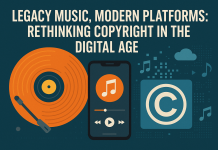I am pleased to bring to you our next guest post by Angad Singh Makkar. Angad is currently a 4th year student at Jindal Global Law School. He was the winner of the Global Anti-Trust moot court competition, organised by Antolin Scalia law school, George mason University, Washington DC. He is also representing his university in the Oxford IP moot 2018-19.
Storage equals Distribution?
Recently, the CJEU in Syed, Case C-572/17 dealt with the ambit of the exclusive right of distribution conferred upon the holder of a copyright, and reflected upon the various stages of a transaction where this right can be enforced. This question arose as the claimants alleged that Mr. Syed, who sold clothes and accessories bearing rock music motifs, had infringed the copyright on their motifs by placing them on his goods. Though Syed’s sale of such items in his retail shop would irrefutably amount to copyright infringement, it was unclear whether the storage of goods bearing copyright-protected motifs would also amount to infringement of the author’s exclusive right of distribution under Article 4(1) of Directive 2001/29 (‘Info Soc Directive’).
The Court drew a parallel with Article 6 of the WIPO Copyright Treaty (‘CT’), which codifies the right of distribution as the ‘exclusive right of authorizing the making available to the public of the original and copies of their works through sale and other transfer of ownership’.[i] Building upon this, it observed that the notion of distribution can incorporate the ‘acts or steps preceding the conclusion of a contract of sale’ as well.[ii] The lack of eventual transfer of ownership was deemed immaterial by the Court, as the mere act of using copyrighted work without the right holder’s consent and with the objective of making a sale was held to be sufficient for an infringement claim under the aforementioned Article 4.[iii]
For an infringement claim on stored goods to prevail however, the Court stressed upon the need to prove an intent to distribute the goods without the right holder’s consent. The following guiding factors (which are not exhaustive) were put forth to assist the determination of intent:
- regular restocking of the shop with goods from storage,
- accounting elements,
- current contracts of sale and
- volume of sales as compared with the volume of stored goods.[iv]
Thus, the CJEU took a laudable step in its efforts to mitigate and deter counterfeiting by expanding the scope of the distribution right to include the storage of counterfeit goods provided the intent to distribute (or sell) these goods can be reasonably showcased. Rightsholders can now not only seek remedies for copyright infringement against goods that involve an actual transfer of ownership, but they can even extend these claims to warehouse storage of counterfeits.
Position under US Copyright Law
The distribution right is embodied under Section 106(3) of the Copyright Act, which grants exclusive rights to the owner of copyright to ‘to distribute copies or phonorecords of the copyrighted work to the public by sale or other transfer of ownership, or by rental, lease, or lending’.[v] The wording of this section is strikingly similar to the aforementioned Article 6 of the CT, which the CJEU has expressly relied upon as well. However, jurisprudence pertaining to distribution rights in the United States been far from cohesive or consistent, as compared to the incrementally expansive approach adopted by the CJEU.
The discussion on offers to distribute, or a ‘making available’ right, falling within the ambit of distribution rights has been predominantly centered around the digital realm.[vi] Essentially, proponents of an expansion of the distribution right have argued that this right is infringed at the stage when one makes a copyrighted work publicly available without the consent of the right holder. For instance, the 9th Circuit held that uploading copyrighted files to a peer-to-peer music sharing website’s search index amounts to a violation of exclusive distribution rights of a right holder.[vii] Implications of an expanded distribution right have extended beyond the digital realm too. In the library lending context, for instance, the 4th Circuit (in Hotaling) ruled that a library completes all steps necessary for distribution to the public upon adding a work to its collection, listing said work in its catalog and making it available to the browsing public.[viii] At this stage, the library can accordingly be held liable for infringement of the right holder’s exclusive distribution right.
Decisions along these lines evidently illustrate a rationale similar to that of the CJEU, insofar as the act of making available a copyrighted work to the public, without the rightsholder’s consent, satisfies the threshold for infringement. The actual act of distribution, which can only take place once a member of the public downloads the musical work or borrows the listed book, is deemed irrelevant. If one were to approach the Syed case with the reasoning put forth by the 4th Circuit or the 9th Court discussed above, the decision would most likely mirror that of the CJEUs.
However, a District Court of the United States has expressly refuted such inferences in In Re Napster Inc. Copyright Litigation.[ix] The plaintiffs therein relied upon the dictum in Hotaling, and argued that lack of actual transfer of the copyrighted works should be immaterial while ascertaining the defendants’ liability vis-à-vis the plaintiffs’ distribution rights. The Court disagreed completely, and, on the basis of case-law holding the contrary, deemed the dictum in Hotaling inapplicable. Accordingly, the Court upheld a strict requirement of actual dissemination or actual transfer to prove claims of infringement of the right holder’s distribution right. Mere offers to distribute were thus placed beyond the scope of Section 106(3). This ruling completely opposes the CJEUs progressive stance in Syed, and it is unfortunate that United States jurisprudence on distribution rights has failed to consistently reprimand blatant instances of copyright infringement.
Position under Indian Copyright Law
Section 14 of the Copyright Act lays down the exclusive rights granted to a right holder by virtue of his/her copyright in a work.[x] However, the concept of distribution rights is addressed squarely under Section 51(b), which puts forth secondary acts of infringement. Specifically, any person who makes for sale or hire, or by way of trade displays or offers for sale or distributes for the purpose of trade any infringing copies of the work can be held liable for copyright infringement.[xi] These provisions are sufficiently precise and offers for sale (synonymous with offers to distribute) are even explicitly brought within the ambit of copyright infringement. Similarly, making any infringing copies of the work for sale purposes are also enumerated as a ground for infringement. These are both clear-cut instances of acts preceding the conclusion of a contract of sale, similar to storage of infringed works – which one can surmise would fall squarely between the making for sale of an infringed work and it being offered for sale on a transactional timeline. In this light, it is reasonable to assume that storage of counterfeit goods, though not explicitly enlisted under the Copyright Act, would also amount to a secondary act of infringement in India. This assumption is further substantiated by India being a contracting party to the CT,[xii] Article 6 of which played a key role in shaping the CJEUs expansive approach towards distribution rights in Syed.
Though jurisprudence on the application and scope of Section 51(b) has been fairly limited, the Bombay High Court made several pertinent observations on these provisions in J.N. Bagga v. All India Reporter.[xiii] Particularly, the Court emphasized upon the encompassing nature of infringement claims under Section 51(b), which is triggered the moment one makes an infringing work with a view to sell. All intervening stages between this initial moment up till the conclusion of the contract of the sale (which may not even necessarily occur) are covered as offences of copyright infringement.[xiv] Through its expansive interpretation of the statute, the Court was thus able to conclude that even newspaper advertisements meant to attract offers from customers, though not exactly offers for sale, would attract liability under these provisions at each of the places where the advertisement reaches.[xv] The rationale of the Bombay High Court undoubtedly suggests that to meet the threshold for infringement under Section 51(b), all that needs to be shown is the possession of an infringing work and an indication of willingness to sell the same. It is not outlandish to suggest that storage of counterfeit goods meets this threshold, provided the intent to sell those goods (as elucidated by the CJEU in Syed) is adequately proven.
Conclusion
The CJEUs latest move to impose enhanced liability for counterfeiting and copyright infringement by expanding exclusive distribution rights is extremely encouraging. Though the muddled jurisprudence on this matter in the United States complicates its applicability under American copyright law, the position under Indian copyright law should ideally mirror the CJEUs approach. Given the wide scope of Section 51(b) of the Copyright Act, an expansive interpretation of a rightholder’s distribution rights, so as to cover storage of infringed works as a ground for infringement, is a viable remedy – one that could massively assist India’s attempts to combat counterfeiting.
[i] WIPO Copyright Treaty, art 6.
[ii] Case C-572/17 Imran Syed ECLI:EU:C: 2018:1033, para 23.
[iii] Ibid, paras 25 and 26.
[iv] Ibid, para 39.
[v] 17 USC §106(3).
[vi] United States Copyright Office, ‘The Making Available Right in the United States’ (Report of the Register of Copyrights, February 2016) <https://www.copyright.gov/docs/making_available/making-available-right.pdf>.
[vii] A&M Records v Napster 239 F3d 1004, 1014 (9th Cir 2001).
[viii] Hotaling v Church of Jesus Christ of Latter‐Day Saints 118 F3d 199, 203 (4th Cir 1997).
[ix] See, In Re Napster Inc Copyright Litigation 377 F Supp 2d 796 (ND Cal 2005).
[x] Copyright Act 1957, s 14.
[xi] Ibid, s 51(b)(i) and (ii).
[xii] WIPO Copyright Treaty, Contracting Parties <https://www.wipo.int/treaties/en/ShowResults.jsp?lang=en&treaty_id=16>.
[xiii] See, JN Bagga v All India Reporter AIR 1969 Bom 302.
[xiv] Ibid, 308.
[xv] Ibid, 309.

















